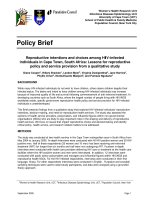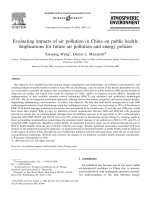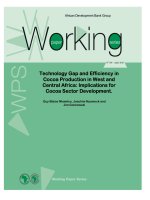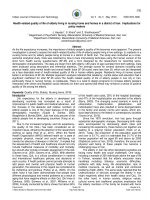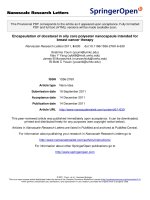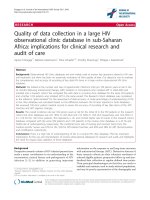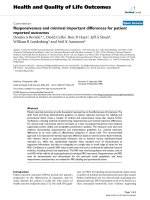Technology Gap and Efficiency in Cocoa Production in West and Central Africa: Implications for Cocoa Sector Development. ppt
Bạn đang xem bản rút gọn của tài liệu. Xem và tải ngay bản đầy đủ của tài liệu tại đây (373.36 KB, 18 trang )
N
o
104 - April 2010
Technology Gap and Efficiency in
Cocoa Production in West and
Central Africa: Implications for
Cocoa Sector Development.
Guy Blaise Nkamleu, Joachim Nyemeck and
Jim Gockowski
Editorial Committee
Kamara, Abdul B. (Chair)
Anyanwu, John C.
Aly, Hassan Youssef
Rajhi, Taoufik
Vencatachellum, Desire
Salami, Adeleke
Moummi, Ahmed
Coordinators
Copyright © 2010
A
fricain Development Bank
Angle des trois rues: Avenue du Ghana,
Rue Pierre de Coubertin, Rue Hédi Nouira
BP 323 -1002 TUNIS belvédère (Tunisia)
Tél: +216 71 333 511 / 71 103 450
Fax: +216 71 351 933
E-mail:
Rights and Permissions
A
ll rights reserved.
The text and data in this publication may be
reproduced as long as the source is cited.
Reproduction for commercial purposes is
forbidden.
The Working Paper Series (WPS) are produc-
ced by the Development Research
Department of the African Development Bank.
The WPS disseminates the findings of work in
progress, preliminary research results, and
development experience and lessons, to
encourage the exchange of ideas and innova-
tive thinking among researchers, development
practitioners, policymakers, and donors. The
findings, interpretations, and conclusions
expressed in the Bank’s WPS are entirely
those of the author(s) and do not necessarily
represent the view of the African Development
Bank, its Board of Directors, or the countries
they represent.
Working Papers are available online at
http:/www.afdb.org/
Correct citation : Nkamleu, Guy Blaise; Nyemeck Joachim: Gockowski Jim (2010), Technology Gap an
d
Efficiency in Cocoa Production in West and Central Africa: Implications for Cocoa Sector Development, Working
Papers Series N° 104, African Development Bank, Tunis, Tunisia.
Technology Gap and Efficiency in Cocoa
Production in West and Central Africa:
Implications for Cocoa Sector Development
(1)
Guy Blaise Nkamleu, Joachim Nyemeck and Jim Gockowski
______________
AFRICAN DEVELOPMENT BANK GROUP
Working Paper No. 104
April 2010
(1) Guy Blaise Nkamleu is Principal Post Evaluation Officer, African Development Bank, Tunis,
Tunisia ; Joachim Nyemeck is Impact Assessment Post Doctoral fellow, Forum for Agricultural
Research in Africa (FARA), Kano, Nigeria; and Jim Gockowski is Coordinator, Sustainable Tree
Crop Program, International Institute of Tropical Agriculture (IITA), Accra, Ghana
Office of the Chief Economist
Abstract
Guy Blaise Nkamleu, Joachim Nyemeck and Jim Gockowski
This paper applies the recently
developed metafrontier function
technique to investigate productivity
potentials and efficiencies in cocoa
production in West and Central Africa.
The methodology enables the estimation
of national technology gap ratios (TGRs)
by using a decomposition result
involving both the national production
frontiers and the (regional)
metaproduction frontier. Empirical
results are derived using a
comprehensive dataset collected during
one of the larger surveys of cocoa
farmers in four West and Central Africa
countries, namely Cameroon, Ghana,
Nigeria and Cote d’Ivoire. The data and
analysis support the view that technical
efficiency in cocoa production is globally
low, and technology gap plays an
important part in explaining the ability of
cocoa sector in one country to compete
with cocoa sectors in other countries in
the West and Central Africa region. The
paper ends by highlighting relevant
strategies for sustainable cocoa
development in Africa.
Key words: Productivity potential, efficiency, cocoa farmers, metaproduction function, Africa
JEL classification: O47 ; Q18 ; C51
Introduction
The centrality of agriculture to the development of least developed countries or developing
economies is now beyond dispute. A vast body of knowledge has assigned a phenomenal role
to agriculture in the early stages of industrialisation. In West and Central Africa, agriculture has
continued to play a dominant role in the provision of food, raw material for industries,
employment for the majority, and foreign earnings, which are used in financing development
activities. In the course of the last 40 years, industrial tree crops, notably cocoa, coffee, oil palm,
and rubber, have dominated the export agriculture.
Perennial tree crop systems in Africa are important for national macroeconomic balances and
rural livelihoods. In a period of rapid globalisation and food crisis, countries in Africa are
pursuing their comparative productive advantage to foster growth under a new liberal economic
context. The pursuing of comparative advantage implies a continued (if not larger) role for
tropical commodity exports in order to generate foreign exchange and to promote economic
growth.
Among the perennial tree crops, cocoa sector is of particular interest for West and Central
Africa, and for the global chocolate industry. Approximately 70 percent of the world supply of
cocoa originates from there. Producing countries derive a large proportion of their foreign
income from cocoa. For example, in 2001, Côte d’Ivoire exported more than 1.4 million tons of
cocoa. This contributed about 40 percent of exports, 14 percent of GDP, and more than 20
percent of government income (Nkamleu and Kielland 2006).
Recent global and African production trends are shown in Table 1. In Africa, cocoa production is
dominated by four countries. Côte d’Ivoire and Ghana produce approximately 41 percent and 17
percent of the world output respectively. The other two important producers are Cameroon and
Nigeria, each contributing approximately five percent of the world cocoa production.
In the 1980s, the cocoa sector experienced an economic recession as the world cocoa market
went through a period of extremely low prices. The stagnation and decline in this sector during
the period paralleled the overall collapse in economic growth in sub-Saharan Africa. The price
received by farmers has hardly risen above $0.50 USD per kg. With the new liberal economic
environment and within the world globalisation context, new strategies and policies need to be
established to take up the fresh challenges that have arisen. The main one is how to increase
cocoa production to meet up with income and development needs. Attaining these goals require
a drastic increase in cocoa productivity.
In Africa, growth in the cocoa sector has been achieved by increasing the area cultivated rather
than by improving yield. Indeed, cocoa cultivation is among the most significant causes of the
near disappearance of the West African rainforest (Gockowski et al. 2000; Nkamleu and Ndoye
2003). The conflict between the poverty alleviation opportunity cocoa presents and the
environmental challenge associated with the expansion of its production underscores the need
to revitalise its productivity in the region (Nkamleu and Coulibally 2000).
Cocoa productivity levels can be enhanced either by improving technical efficiency and/or by
improving technological application. A relevant question for agricultural policymakers is whether
to pursue a strategy directed towards technological change (bringing new technologies) or a
strategy towards efficiency (improving the use of existing technologies) (Nkamleu 2004;
Nkamleu 2004b). The presence of shortfalls in production efficiency means that output can be
increased without requiring additional conventional inputs and without the need for new
technology. If this is the case, then empirical measures of efficiency are necessary in order to
determine the magnitude of the gain that could be obtained by improving performance with a
given technology. In the presence of technological gap, technical progress is the rational
strategy to adopt to significantly increase agricultural production.
In this paper, we apply recently developed techniques – a metafrontier production function – to
investigate productivity potentials (technological gap) and efficiency differences of cocoa sectors
in different countries in West and Central Africa. This methodology has the advantage of making
it possible to compare technical efficiency of agriculture in different countries that may not share
the same technology. The study used data from one of the larger surveys of cocoa farmers
carried out in Africa. The paper is divided into five sections. Section 2 presents the theoretical
framework and econometric model used in this article. Section 3 describes data and presents
the empirical model. Section 4 discusses the results, while section 5 ends the discussions with
conclusions and some policy lessons.
2. Theoretical framework and econometric model
The metaproduction function concept used in this paper was first introduced by Hayami (1969)
and Hayami and Ruttan (1970, 1971). As stated by Hayami and Ruttan (1971, p. 82), “The
metaproduction function can be regarded as the envelopment of commonly conceived
neoclassical production functions.”
In the analysis, we employed a stochastic frontier metaproduction, which is characterised by the
fact that the error term comprises a symmetric random error and a non-negative technical
inefficiency term as in the stochastic frontier production function model originally proposed by
Aigner, Lovell and Schmidt (1977) and Meeusen and van den Broeck (1977).
This concept of stochastic frontier metaproduction function is extensively discussed by Battese
and Rao (2002) and Battese et al. (2004), and is adapted here to serve our purpose. Let us
consider that the whole sample of producers is composed of K subsets (K>1) representing K
countries, and farmers in each country operate under a country specific technology,
k
T
(k=1,
2,……,K).
Since all the K’s technology can be considered as a subset of an “over-arching technology”
referred to as the meta-technology, which is represented by
∗
T
, the meta-technology can be
stated as the “absolute best” technology produced by the state of knowledge, and is accessible
if neither endowment nor policy constraints are facing producers. Battese et al. (2004) showed
how technical efficiency scores for farms across countries can be estimated using a stochastic
frontier metaproduction function model, and used a decomposition result to present an analysis
of regional productivity potential and efficiency levels. The same type of analysis is performed
here.
Suppose that the inputs and outputs for farms in a given cocoa sector are such that stochastic
frontier production function models are defined for different countries within the cocoa sector.
Suppose also that for the j-th country, there are sample data on N
j
farms that produce cocoa
from the various inputs. The stochastic frontier model for this country is defined by:
,),(
ijij
UV
jijij
exfY
−
=
β
,, ,2,1
j
Ni = (1)
The V
ij
s in the equation are assumed to be identically and independently distributed as
),0(
2
v
N
σ
-random variables, independent of the U
ij
s, which are defined by the truncation (at
zero) of the
),(
2
σμ
ij
N -distributions. For simplicity, the subscript, j, is omitted and following
Battese and Coelli (1992, 1995), the model for the j-th country can be written as:
.),(
iiiii
UVxUV
ii
eexfY
−+−
≡=
β
β
(2)
This expression assumes that the exponent of the frontier production function is linear in the
parameter vector, β, so that
i
x is a vector of functions (e.g., logarithms) of the outputs for the i
th
farm. The metafrontier production function model for farms in all countries of the cocoa sector is
expressed by:
,, ,2,1,),(
*****
*
NieexfY
iiiii
UVxUV
ii
=≡=
−+−
β
β
(3)
∗
β
denotes the vector of parameters for the metafrontier function such that
.
ββ
ii
xx ≥
∗
(4)
Equation (4) states that the metafrontier dominates all the country’s frontiers. That is the meta-
technology that describes the unconstrained best practice according to the state of knowledge.
The metafrontier production function is thus defined as a deterministic parametric function (of
specified functional form), such that its values are no smaller than the deterministic components
of the stochastic frontier production functions of all the different groups involved.
The observed output for any unit can be consequently defined by the stochastic frontier for the
j
th
group (equation 2) using the metafrontier function (3), such that:
ii
i
i
i
Vx
x
x
U
i
e
e
e
eY
+−
∗
∗
××=
β
β
β
(5)
The first term of the right-hand side of equation (5) is the technical efficiency relative to the
stochastic frontier for the jth group,
i
ii
U
Vx
i
i
e
e
Y
TE
−
+
==
β
(6)
The second term on the right-hand side of equation (5) is the technology gap (TGR) for the
sample farm involved,
∗
=
β
β
i
i
x
x
i
e
e
TGR
(7)
This measures the ratio of the output for the frontier production function for the jth group,
relative to the potential output that is defined by the metafrontier function, given the observed
inputs. The technology gap ratio ranges from zero to one because of equation (4). The technical
efficiency of the ith farm, relative to the metafrontier, denoted by
∗
i
TE , is defined in an
analogous way to equation (6). It is the ratio of the observed output relative to the last term on
the right-hand side of equation (5), which is the metafrontier output adjusted for the
corresponding random error, i.e.,
ii
Vx
i
i
e
Y
TE
+
∗
∗
=
β
(8)
Equations (5)-(8) imply that an alternative expression for technical efficiency relative to the
metafrontier is given by:
iii
TGRTETE ×=
∗
(9)
Equation (9) implies that the technical efficiency ratio of the ith producer relative to the
metafrontier is the product of the technical efficiency relative to the stochastic frontier for the
given group and the TGR. In other words, the technical efficiency scores for producers that don’t
use the same technology can be corrected (to make them comparable) using the distance
between the regional frontier and the leading metafrontier. Note that this precludes the technical
efficiency with respect to the meta-technology from being greater than the technical efficiency
measure relative to the regional frontier.
The
−
∗
β
ˆ
parameters can be estimated by solving the optimisation problem (Battese et al.
2004):
).(
1
)(
ˆ
)
ˆ
(min
jii
N
i
jii
xxts
xxL
ββ
ββ
≥
−≡
∗
=
∗
∑
(10)
Some econometric advantages of applying the metaproduction function are discussed by Lau
and Yotopoulos (1989). However, the lack of comparable data and the presence of inherent
differences across regions are the major limitations of the approach. More generally, the major
weakness of the stochastic frontier model is its failure to provide an explicit distribution
assumption for the inefficiency term. Different assumption about the distribution of the
disturbance can sometimes produce widely different results.
3. Data and empirical model
The present study is based on data collected by the International Institute of Tropical Agriculture
in 2002 in Côte d’Ivoire, Ghana, Nigeria, and Cameroon. A baseline survey of major cocoa-
growing regions of West and Central Africa was conducted to provide baseline parameter
estimates of production systems in the sub-region. In all of the countries indicated, villages and
clusters of households were randomly selected and household heads interviewed using
structured questionnaires (Table 1).
In Nigeria, 1,083 households were visited in 35 villages and towns of Ondo State, which
accounts for more than 40 percent of annual cocoa production in Nigeria. In Cameroon, 1,003
households in 83 villages in the Southwest, Center, and South Provinces were visited. Cocoa
output from these sites accounts for over 80 percent of national production. In Ghana, the
surveys were conducted with 1,000 households from 85 villages in the Brong Ahafo, Ashanti,
Eastern, and Western regions, which together account for approximately 90 percent of national
cocoa production. In Côte d’Ivoire, a list of farmers obtained from a national census of cocoa
and coffee producers conducted in 1998 presented the opportunity to select households using a
random number procedure. A total of 1,372 households from 20 subdivisions and 134 villages,
hamlets, and cocoa “camps” across the cocoa belt of Côte d’Ivoire were interviewed.
Table 1: Number of villages and farmers surveyed.
Villages Farmers
Côte d’Ivoire 134 1372
Ghana 85 1000
Nigeria 35 1083
Cameroon 83 1003
Total 337 4458
The functional form chosen for the stochastic frontier function for all the countries is the translog
form. The translog functional form for the ith farmer in a particular country is defined by:
∑∑∑
==≥
−+++=
4
1
4
1
4
0
ln
mmmk
iikimimkmmi
uvxxxY
i
βββ
(11)
Indices
mandi
respectively represent the input m used by farmer .i
i
Yln denotes the natural
logarithm of the total quantity of cocoa produced, measured in kilograms.
Four inputs were included in the model. Most of these variables have been commonly used in
estimating agricultural production frontiers for developing countries (Bravo-Ureta and Pinheiro
1997; Nyemeck et al. 2008). ‘x
1
’ denotes the total productive cocoa area in hectares. Generally,
a cocoa tree becomes productive after around six years. ‘x
2
’ represents the cost of pesticide
(fungicides and insecticides) used in cocoa production. It is measured in USD. ‘x
3
’ stands for the
amount of labour, which includes both family, exchange, and hired labour in man-days. ‘x
4
’
refers to the average age of cocoa farms measured in years.
sv
i
are assumed to be
independently and identically distributed
),0(
2
v
N
σ
two-sided random errors, independently of
the
su
i
.
4. Results
The single-stage maximum likelihood procedure of the FRONTIER 4.1 program (Coelli 1996)
was used to estimate the parameters of the stochastic frontiers (maximum attainable output) for
each country and for pooled data. Results are presented in Table 2.
Two sets of specification tests were performed. First, the null hypothesis that there are no
technical efficiency effects in the models is tested using a likelihood ratio (LR) test of the one-
sided error. The null hypothesis is strongly rejected as the LR test statistics 55.82, 42.80, 52.68,
51.98, and 135.99 for Cameroon, Ghana, Nigeria, Côte d’Ivoire, and pooled stochastic frontier,
respectively, are all greater than the tabular Ki-square value (3.84). Second, if the stochastic
frontiers across nations do not differ, then it is possible to just use the pooled stochastic frontier.
Therefore, an LR test was performed to see if all the national stochastic frontiers shared the
same technology. A generalised LR test statistic for the null hypothesis that the national
frontiers were identical for all cocoa sectors in West and Central Africa was calculated. The LR
Statistic is defined by
[
]
[
]
.))(ln())(ln(2))(ln(/))(ln(2
1010
HLHLHLHL −
−
=
−=
λ
, where
))(ln(
0
HL is the value of the loglikelihood function for the stochastic frontier estimated by
pooling the data for all countries, and
∑
=
=
4
1
1
))(ln(
i
i
LLFHL
is the sum of the values of the
loglikelihood functions for the four national production frontiers.
The degrees of freedom for the Chi-square distribution involved are 78, the difference between
the number of parameters estimated under
1
H and .
0
H The value of the LR statistic was found
to be 668.940, which is highly significant. This result strongly suggests that the four national
stochastic frontiers for cocoa farmers in West and Central Africa are not the same, implying that
production structure and technology are different among the four countries.
The parameters of the metafrontier are estimated by solving the LP problem. The LP problem in
equation (10) was solved using Lingo software. The LP was preferred in the present paper after
Battese, Rao, and O’Donnell (2004) found an insignificant difference between the LP and the
QP estimates for the parameters of the metafrontier function. However, as expected, there are
significant differences between the metafrontier coefficients and the corresponding coefficients
of the stochastic frontier for the pooled data.
The values of the TGR, together with the technical efficiencies obtained from the national
stochastic frontiers (TE) and the metafrontier (TE*) were computed for all farmers in the different
countries. Summary statistics for these measures are presented in Table 3.
The TGR values represent the distance between the metafrontier and the national efficiency
frontier for a given vector of inputs. For the studied countries, the technical efficiency scores
ranged from 0.44 to 0.74, with a weighted average of about 0.61, indicating that the cocoa
sector in West and Central Africa produces on average, only 61 percent of the potential output
given the technology available in each country. This result evidences that technical efficiency is
quite low. It also demonstrates that improving the managerial skills and technical capacity of
farmers without adding any input can help increase agricultural output by up to 39 percent.
Nigeria is the relatively most efficient country while Ghana is the least efficient. Imperfect
competition, financial constraints etc., may cause a farmer not to be operating at optimal level.
The low efficiency score is a significant finding. It suggests that in the achievement of high
levels of performance in cocoa production in West and Central Africa, technical efficiency is an
important constraint.
The more interesting feature is the difference between the average technical efficiency scores
from the national and the metafrontier models. For example, the average technical efficiency for
Cameroon relative to the metatechnology is only 45 percent, while its mean efficiency is quite
large with respect to its own national frontier (65 percent). The differences between the two
efficiency scores indicate the order of bias of the technical efficiencies obtained by using the
national frontier, relative to the technology available for the cocoa sector in West and Central
Africa. Generally, the technical efficiencies from the national frontiers should be greater than
those obtained from the metaproduction frontier because of the constraint in the linear
programming problem (equation 10).
Estimates for the technology gap ratios (TGR) reveal that the four countries have productivity
potential ratio ranging between 0.70 and 0.96. These values can be interpreted as the
technological gap faced by the cocoa sector in those countries when their performances are
compared with the regional level. Cameroon has the lowest productivity potential ratio. This
suggests that even if all cocoa farmers from Cameroon achieved best practice with respect to
the technology observed in their country, they will still be lagging behind because the
technology in Cameroon lags behind regional technology with a TGR of 0.70. This implies that
even if the mean cocoa producer in Cameroon were fully technically efficient (i.e., producing on
the national efficiency frontier), he/she could still increase output by 30 percent if he/she
adopted the most efficient meta-technology in the region. The technology gap ratios were much
greater in Nigeria and Côte d’Ivoire (0.96 and 0.92 respectively), indicating that the technologies
in these countries are near the possibilities’ frontier of the meta-technology.
Figure 1 illustrates the results presented above. In the same graphic are frontier curves of the
four countries, and the metafrontier curve. The inefficiency levels are indicated by the distance
between the production point and the frontier curve, while the technology gap ratios are
represented by the distance between the country-frontier and the metafrontier curves.
From a policy point of view, these regional differences show the type of interventions necessary
to enhance productivity of the cocoa sector in each region. In Cameroon, priority should be on
reducing the technology gaps by investing in new technological innovations already existing
within the region. A country-to-country technology transfer arrangement should be encouraged.
In Nigeria and Cote d’Ivoire, the findings suggest that to achieve significant growth in the cocoa
sector, priorities should be on improving the know-how of cocoa farmers. This could be
achieved by putting in place sound government extension programmes and the development of
rural credit institutions to help cocoa farmers acquire technologies already available in the
country. In Ghana, both types of strategies should be pursued to tackle the observed very low
efficiency level and the technology gap.
Table 2: The maximum-likelihood estimates of the translog stochastic frontiers for cocoa
farmers in different countries in West and Central Africa, together with estimates of parameters
of the metafrontier production function.
Variable Coefficient Cameroon Ghana Nigeria
Côte
d’Ivoire Pooled
Meta
(LP)
Constant
β
0
6.715
(11.321)
b
4.941
(-10.822)
5.96
(7.406)
5.293
(13.718)
4.951
(25.482) 5.727
Area
β
1
0.645
(3.692)
0.728
(5.053)
0.652
(3.135)
0.767
(4.406)
0.931
(12.020) 0.689
Labour
β
2
0.310
(4.12)
-0.025
(-0.142)
0.026
(0.115)
0.509
(2.662)
0.181
(2.113) 0.252
Pesticides
β
3
-0.366
(-5.842)
-0.075
(-1.846)
-0.585
(-6.112)
-0.235
(-5.464)
-0.062
(-1.760) 0.0001
Trage
β
4
-0.277
(-1.223)
0.955
(3.577)
0.254
(0.685)
0.759
(3.021)
0.91
(7.763) 0.387
Area
2
β
11
0.002
(0.072)
0.055
(1.957)
-0.007
(-0.268)
-0.092
(-3.036)
0.009
(0.604) 0.0017
Labour
2
β
22
0.046
(1.644)
-0.001
(-0.030)
-0.017
(-0.612)
-0.003
(-0.094)
0.036
(2.717) 0.0109
Pesticide
2
β
33
0.031
-12.258
0.013
(4.529)
0.066
(17.065)
0.023
(6.301)
0.046
(13.307) 0.0424
Trage
2
β
44
-0.003
(-0.097)
-0.11
(-2.281)
-0.02
(-0.347)
-0.155
(-3.345)
-0.156
(-7.807) -0.04
Area*Labour
β
12
-0.111
(-2.157)
0.026
(0.619)
0.008
(0.175)
0.086
(1.552)
0.031
(1.238) 0.009
Area*Pesticide
β
13
0.002
(0.234)
-0.006
(-1.014)
-0.03
(-1.641)
-0.014
(-1.891)
-0.061
(-6.843) -0.0018
Area*Trage
β
14
-0.085
(-2.014)
-0.028
(-0.534)
-0.059
(-1.196)
0.019
(0.302)
-0.115
(-4.354) -0.0012
Labour*Pesticide
β
23
-0.013
(-1.140)
-0.002
(-0.364)
0.018
(0.955)
-0.009
(-1.260)
-0.007
(-0.756) -0.0003
Labour*Trage
β
24
0.025
(0.47)
0.018
(0.292)
0.01
(0.161)
-0.094
(-1.518)
-0.018
(-0.607) 0.0163
Pesticide*Trage
β
34
0.03
(2.228)
-0.017
(-2.049)
0.003
(0.105)
0.022
(2.617)
0.015
(1.408) 0.0131
Variance parameters
)(
222
vu
σσσ
+=
1.054
(3.122)
0.703
(6.169)
1.631
(3.20)
1.277
(3.134)
0.937
(9.437)
)/(
222
vuu
σσσγ
+=
0.712
(7.209)
0.753
(7.758)
0.802
(12.673)
0.785
(13.3)
0.624
(13.967)
Log Likelihood -866.31 -930.66 -1042.41 -1138.48 -4312.33
b
Variables in parenthesis are asymptotic t-ratios
Table 3: Summary statistics for the TGRs and the technical efficiencies obtained from the
national stochastic frontiers and the metafrontier production function for West and Central Africa
cocoa farmers
(**)
Cameroon Ghana Nigeria
Côte
d’Ivoire Prob.
Technical Gap Ratio
(TGR)
0.70
(0.08)
0.88
(0.014)
0.96
(0.015)
0.92
(0.16) < 0.001
National Technical
Efficiency (TE)
0.65
(0.16)
0.44
(0 .19)
0.74
(0.12)
0.58
(0.17) < 0.001
Metafrontier Technical
Efficiency (TE*)
0.45
(0.12)
0.39
(0.16)
0.71
(0.12)
0.53
(0.16) < 0.001
(**)
figures in parenthesis are standard deviations
Figure 1: Graphical representation of the performance of cocoa sector in West and Central
Africa.
Input
, x
Output Y
Meta frontie
r
•
Y
S.A
•
Northern Africa frontie
r
Southern Africa frontie
r
Central Africa frontie
r
•
Y
Input
, x
Output Y
Meta frontier
•
Y
Cameroon
•
Y
Nigeria
Cote d’Ivoire frontie
r
Cameroon frontier
Nigeria frontier
•
Y
Ghana
Ghana frontie
r
•
Y
Cote d’Ivoire
5. Conclusion
In this paper, we apply a recently developed metafrontier function technique to investigate
productivity potentials and efficiencies in cocoa production in West and Central Africa. Since
technology is a representation of the state of knowledge pertaining to the transformation of
agricultural inputs into output, we conceptualise the existence of an over-arching technology
referred to as the metatechnology, which is represented by the metafrontier production function.
The methodology enables the estimation of national technology gap ratios by using a
decomposition result involving both the national production frontiers and the (regional)
metaproduction frontier. Empirical results are derived using a comprehensive dataset collected
during one of the larger surveys of cocoa farmers in four West and Central African countries,
namely Cameroon, Ghana, Nigeria, and Cote d’Ivoire.
Separate stochastic frontier models are estimated for farmers in these countries, along with a
stochastic metaproduction frontier to obtain alternative estimates for the technical efficiencies of
farmers in the different states. The results of the analysis show large productivity potential gaps
between countries of the region in relation to cocoa production. The gaps range between 0.70
and 0.96. These values can be interpreted as the technological gap faced by the cocoa sector in
those countries when their performances are compared with the regional level. Cocoa sector in
Cameroon had the lowest technology gap, while that of Nigeria had the highest. In terms of
production efficiency, Nigeria’s cocoa sector has the highest mean technical efficiency relative
to the national frontier and also to the regional frontier. Ghana appears as the least performing
region. The data used in this study support the view that technical efficiency score is globally
quite low and technology gap plays an important part in explaining the ability of the cocoa sector
in one country to compete with cocoa sectors in other regions in West and Central Africa
(Nkamleu 2004b).
From a policy standpoint, the results of this study have important implications for policy
targeting. The fact that cocoa farmers are not realising the full potential of the system indicates
that there is need for sustained improvements on performance. This will require enhanced roles
by the public sector and international agencies in research and extension activities to
significantly raise technical efficiency. New technologies are sometimes introduced in the rural
sector without ensuring that farmers are exploiting their full potential. A promising possibility
may be to train farmers in production programs so that they gain knowledge in crop
management and new technology.
The study makes it possible to identify the type of interventions each country needs to enhance
cocoa production. In some countries, such as Cameroon, the priority target should be to raise
technology (to close the gap between the regional frontier curve and the global frontier curve).
In Cote d’Ivoire and Nigeria, the urgency is on improving the know-how of farmers. The level of
technology in those countries is quite good, but the extent of their exploitation is poor. Knowing
what the right inputs are, how to combine them, and when to use them, are as important as
using more inputs.
References
Aigner, Denis.J., Lovell, C. K., & Schmidt, Peter. (1977). Formulation and Estimation of
Stochastic Frontier Production Function Models. Journal of Econometrics 6 (1), 21-37.
Anderson, Richard G. and Thursby, Jerry G. (1986). Confidence Intervals for Elasticity
Estimates in Translog Models. The Review of Economic and Statistics 68 (4), 647-656
Anti-Slavery International. (2004). The Cocoa Industry in West Africa: A Story of Exploitation.
Battese, George.E., & Coelli, Tim. (1995). A Model for Technical Inefficiency Effects in a
Stochastic Frontier Production Function for Panel Data. Empirical Economics 20 (2),
325-332.
Battese, George.E., & Coelli, Tim.J. (1992). Frontier Production Functions, Technical Efficiency
and Panel Data: With Application to Paddy Farmers in India. Journal of Productivity
Analysis 3 (1), 153-169.
Battese, George.E., & Rao, D.S.Prasado. (2002). Technology Gap, Efficiency, and a Stochastic
Metafrontier Function. International Journal of Business and Economics, 1 (2), 87-93.
Battese, George.E., Rao, D.S.Prasado., & O’Donnell, Christopher.J. (2004). A Metafrontier
Production Function for Estimation of Technical Efficiencies and Technology Gaps for
Firms Operating Under Different Technologies. Journal of Productivity Analysis 21 (1),
91-103.
Boskin, Michael.J., & Lau, Lawrence.J. (1992). Capital, Technology and Economic Growth. In
Technology and the Wealth of Nations, N. Rosenberg, R. Landau, et D.C. Mowery, eds.,
Stanford: Stanford University Press.
Braun, Ann. R, Thiele, Graham., and Fernandez, Maria., 2002. Farmer Field Schools and Local
Agricultural Research Committee: Complementary Platforms for Integrated Decision-
Making in Sustainable Agriculture. ODI, Agricultural Research and Extension, Network
Paper 105.
Coelli, Tim.J. (1996). A guide to FRONTIER Version 4.1: A Computer Program for Frontier
Production Function Estimation. CEPA Working Paper 96/07. School of Economics,
University of New England, Armidale.
Coelli, Tim.J. 1995. Recent Development in Frontier Modelling and Efficiency Measurement.
Australian Journal of Agricultural Economics 39 (3), 219-245.
Delgado, Christopher, L., 1995. Africa’s Changing Agricultural Development Strategies: Past
and Present Paradigms as a Guide to the Future. 2020 Vision Food, Agriculture, and the
Environment Discussion Paper 3. Washington, D.C.: International Food Policy Research
Institute.
Dercon, Stefan. (2003). “Poverty Traps and Development: The Equity-Efficiency Debate
Revisited.” Paper prepared for the Conference on Growth, Inequality, and Poverty,
organised by the Agence Francaise de developpement and the European Development
Research Network (EUDN), September 2003.
Gockowski, J., G.B. Nkamleu and John Wendt (2000). “Implications of Resource-use
Intensification for the Environment and Sustainable Technology Systems in the Central
African Rainforest’’. Book chapter, In DR. Lee and CB. Barrett (eds) Tradeoffs or
Synergies ? : Agricultural intensification, economic development, and the environment.
CAB International, Chapter 11.
Gunaratne, Lokugam.Hewa.P, & Leung, PingSun. (2001). Asian Black Tiger Shrimp Industry: A
Productivity Analysis. In Economics and Management of Shrimp and Carp Farming in
Asia: A collection of Research Papers Based on the ADB/NACA Farm Performance
Survey,
Hayami, Yujiro. (1969). Sources of Agricultural Productivity Gap Among Selected Countries.
American Journal of Agricultural Economics 51 (3), 564-575.
Hayami, Yujiro., & Ruttan, Vernon.W. (1970). Agricultural Productivity Differences among
Countries. American Economic Review, 60 (5), 895-911.
Hayami, Yujiro., & Ruttan, Vernon.W. 1971. Agricultural Development: International
Perspective. Baltimore: John Hopkins University Press.
Kalirajan, Kaliappa.P. & Tse, Yiu Kuen., (1989). Technical Efficiency Measures for the
Malaysian Food Manufacturing Industry. The Developing Economies 27 (2): 174-184.
Lau, Lawrence.J., & Yotopoulos, Pan.A. (1989). The Metaproduction Function Approach to
Technological Change in World Agriculture. Journal of Development Economics 31 (2),
241-269.
Leung, PingSun.S., & Khem.R. Sharma, eds., Bangkok: Network of Aquaculture Centres in
Asia-Pacific (NACA).
Meeusen, Wim., & Van Den Broeck, Julien (1977). Efficiency Estimation from Cobb-Douglas
Production Function with Composed Error. International Economic Review 18 (3), 435-
444.
Mundlak, Yair., & Hellinghausen, Rene. (1982). The Inter-County Agricultural Production
Function: Another View. Amer Journal of Agricultural Economics 64 (4), 664-672.
Nkamleu G.B. and O. Coulibaly (2000). Les Determinants du Choix des Methodes de Luttes
Contre les Pestes dans les Plantations de Cacao et Cafe du Sud-Cameroun. Revue
Economie Rurale No 259 Sept-Oct, 2000.
Nkamleu G.B. and O. Ndoye (2003). Cocoa Based Farming Systems in Humid Forest Zone of
West and Central Africa: Constraints and Opportunities. Proceeding, CORAF/IAC
Consultation Workshop on Science and Technology Strategies for Improving Agricultural
Productivity and Food Security in West and Central Africa, Dakar, Senegal, February 10-
12, 2003. InterAcademy Council, Amsterdam, the Netherlands.
Nkamleu, Guy Blaise (2004). Productivity Growth, Technical Progress and Efficiency Change in
African Agriculture”. Africa Development Review No16, vol.1, pp. 203-222, Blackwell
Publishing Ltd, Oxford, UK.
Nkamleu, Guy Blaise (2004b). L’Echec de la Croissance de la Productivité Agricole en Afrique
Francophone”. Economie Rurale No 279 Janvier-Fevrier, 2004. pp. 55-67.
Nkamleu, G. B. and A. Kielland. (2006). Modelling Farmers’ Decisions on Child Labour and
Schooling in the Cocoa Sector: A Multinomial Logit Analysis in Côte d’Ivoire. Agricultural
Economics, 35 (2006) 319-333.
Nyemeck, B.J., Gockowski, J., and Nkamleu, G.B. (2008). Technical Efficiency and Productivity
Potential of Cocoa Farmers in West African Countries: A Meta Frontier Approach. The
Developing Economies, XLVI-3 (Sept 2008): 242–63.
Ruttan, Vernon.W., Binswanger, Hans.P., Hayami, Yujiro., Wade, William.W., & Weber,
Aadolph. (1978). Factor Productivity and Growth: A Historical Interpretation. In Induced
Innovation: Technology, Institution, and Developments, Binswanger, H.P., and V.W.
Ruttan, eds., Baltimore: John Hopkins Univ. Press.
Sharma, Khem.R., and Leung, PingSun. (2000). Technical Efficiency of Carp Pond Culture in
South Asia: An Application of Stochastic Metaproduction Frontier Function Model.
Aquaculture Economics and Management 4 (3&4), 169-189.
Tiaji, Salaam Blyther., Hanrahan, Charles., & Nicolas, Cook. (2005). Child Labour in West
African Cocoa Production: Issues and US Policy. CRS Report for Congress.
Congressional Research Service.
Udry, Christopher. (1996). “Efficiency and Market Structure: Testing for Profit Maximisation in
African Agriculture” Mimeograph. Yale University. Available at
Accessed October 15, 2007.
Zeller, Manfred., Diagne, Aliou., & Mataya, Charles., 1997a. Market Access by Smallholder
Farmers in Malawi: Implications for Technology Adoption, Agricultural Productivity, and
Crop Income. Agricultural Economics 19(1&2): 219-229.

